Chuojiao is a very complete martial art system that encompasses the development of the full arsenal empty hand, internal development and traditional weaponry. With tactical and distinctive boxing methods, powerfully deadly kicking techniques, dynamic Shenfa (Body methods) and advanced ground fighting (Ditangquan). Chuojiao was developed through countless generations in war and rebellion, designed for battle.
The full name of Chuojiao has sometimes been referred to as ‘Jiufan Yubu Yuanyang Gougua Lianhuan Xuankong Chuojiao’ or [9 Changes, resisiting/wardoff Step Mandarin Ducks Hooking and Hanging Continuouos airborne Piercing Feet]. Chuojiao is also deemed to be a representative of the ancient Wenjia boxing which had been recognised as been one of the best martial arts during the time of Qi Jiguang (1528-1588) and later Chang Naizhou (1724-1783) in their records. It is truly representative of Northern martial arts and requires a lot of effort to practice, since it was created by so many warriors and has absorbed so many different types of combat methods it is also one of the largest systems of martial arts in China. There used to be a saying “Zhili Chu, Shandong Cha’ which referred to the most effective martial arts in Zhili province being Chuojiao, and that of neighbouring Shandong as Cha Quan (which is also a large system). However Chuojiao was also very protected and very rarely taught to outsiders completely.
History and Development of Chuojiao

Chuojiao [戳脚] is one of the most ancient of traditional Chinese martial arts that dates back to at least the Song Dynasty (960-1279), given such a long history it is difficult to assess its exact origin accurately. One of the legends of its origin mentions that a Daoist wanderer named Deng Liang [邓良] who created the style commencing with 18 basic kicking/footwork actions (some research suggests leg actions from the ancient Chinese football game of Cuju [蹴鞠]which was popular in the Song Dynasty) and then deriving 108 variations according to combinations developed from the Abacus that became the essential components of the style.
At the end of the Song Dynasty the style was nicknamed Fist of the Heroes, Fist of the Knights and Kicking Fists. In the Song Dynasty, traditional Chinese martial arts were divided into 4 great sects : Chi , Bo , Chuan, Wen and ten great boxing styles : Hong, Liu, Zhi, Ming, Mo, Tan, Zha, Pao. Hua and Long. Chuojiao is often referred to as belonging to that of the Wen Sect and of the Zhi boxing style, therefore often referred to as Wenjiaquan or Jiu Zhizi. The Wen family were well known fighters at the time owning many businesses including the escorting of valuables – security logistics bureaus.
Legend of Zhou Tong and Yue Fei
Deng Liang is said to have passed his skills to Zhou Tong [周侗]. A legendary martial arts master from the Central Plains (中原) in China. Zhou Tong had practiced martial arts and military strategy (such as Sunzi’s Art of War) from a young age and in his later years started teaching these methods to various disciples. Of those one of the more famous disciples was esteemed Yue Fei [岳飞], a heroic general and Chinese patriarch of the Song Dynasty. Given Yue Fei’s fame and respect by the Chinese population, the style to this day contains a set of practice known as Yue Fei Sanshou. It is said that Zhou Tong being a master of high calibre taught disciples in accordance with purpose, Yue Fei was said to have excelled at military strategy, weaponry (Archery and Spear methods) and practical chinese boxing.
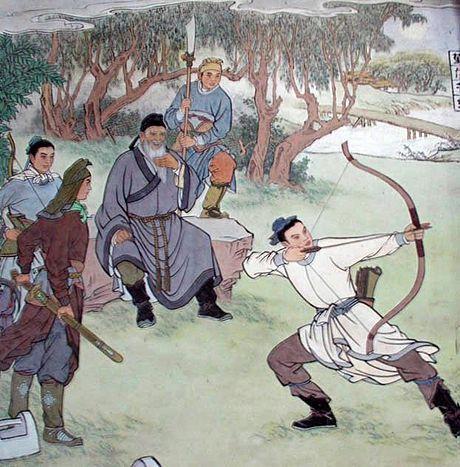
According to the Yuejia Pu (Yue Family Annals), Yue Fei studied some straightforward striking methods, these are considered as the basics of BaFanMen, and to this day have been named Yue Jia Chui (Strikes of the Yue Family). Yue Jia Chui are the basics on which the latter style of Yue Jia Quan in the South (Hubei, Jiangxi provinces) is based upon, it is also the fundamentals of Ba Fan Men (also known as Ba Shan Fan, or Fanziquan). Ba Fan Men was a highly influential style across the Central Plains mixing with many other methods and is the mother of Ying Zhao Fanzi (Eagle’s Claw) and was instrumental in the development by Li Luoneng (who had studied some of its methods) of Hebei Xing Yi Quan (thus the differences from the older Dai Family Xinyi and Xinyi Liuhe methods).
Another Legendary/Folklore claim to fame is that a number of fighters (such as Wu Song & Lin Zhong) in the world-famous Chinese novel Outlaws of the Marsh (Shuihuzhuan-Water Margin) are depicted as Chuo jiao practitioners: also making the style also known as Shuihuquan “Fist of the Outlaws of the Water Margin”. For example in Chapter 28 of the Water Margin Novel “Drunken Wu Song beats Jiang Menshen innkeeper” the words “step of Jade ring, leg of mandarin duck” appeared, these movements being central to Chuojiao.
Legend proclaims that Zhou Tong taught Hebei’s Hu Jiuyi for 8 years, after which he acquired the skills of Yanqingfanzi and Stick Methods. As a result the style later became known as Yanqingquan (Also popular in Cangzhou, Hebei province and Shandong Province). Zhou Tong also taught Lin Zhong the Fanzi boxing and excelled in Spear methods. Wu Song was said to have mastered Chuojiao, Ditangquan and 8 Drunken Immortals.
Military Leaders and Warriors throughout History
In every generation that followed countless experts and masters added to their development until this day. Those ancient arts and masters laid the foundation for the various martial arts known today. In fact Chuojiao is one of the oldest Chinese martial arts still in existence. Having its origin amongst warriors, rebellions and army battallions, the style of Chuojiao continued its development through countless battles. It was trialed, tested and developed generation by generation of not just individuals but complete armies. This enhanced the repertoire of the style by additional various specialised weaponry, as well as boxing methods from various styles and strategies encountered in battle.
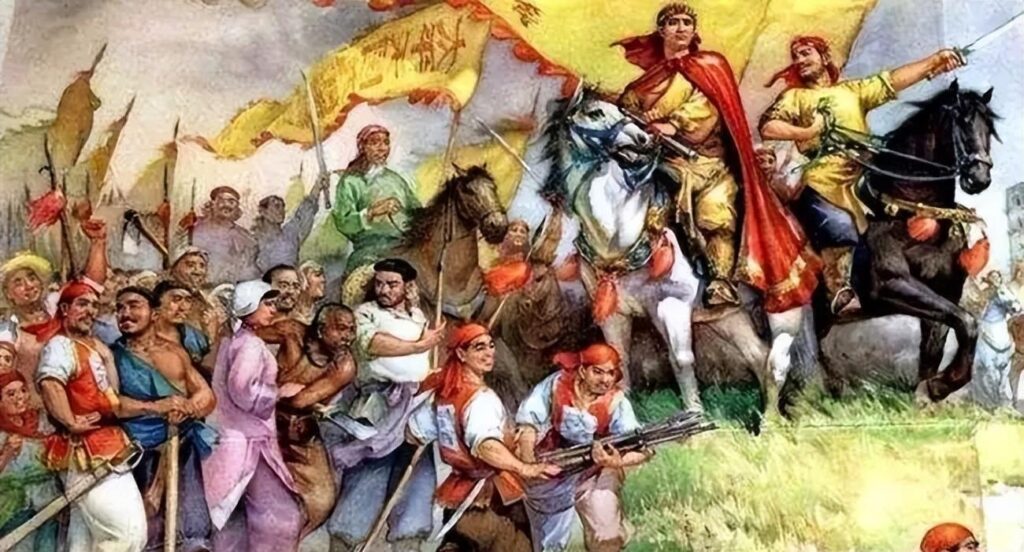
Through the efforts of brave and courageous experts, the art of Chuo Jiao continued its application to battles. Shi Dakai, a leader of the huge Heavenly Kingdom rebellion (1851-1864) (TaiPingTianGuo)- a national rebellion that actually took over and held parts of China and involved more people than the American Civil War – was known for his scholastic and martial interests (Wen/Wu). He taught his troops, the famous Shi Battalion, who actually effectively used the skills of Chuo Jiao against Imperial troops in battle. In Volume 20 of the Unofficial History of the Taiping Heavenly Kingdom, it recounts how Shi’s soldiers fought Qing Imperial troops using the basic jade ring skills of Chuo Jiao taught by their leader. They stood in front of the enemy line with their eyes covered by their hands, and then jumped back about 10 steps. When the enemy came close, they used both feet to kick the enemy soldiers in the abdomen or groin. If the enemy soldiers were stronger, they doubled their kicks and turned their jade rings simultaneously to defeat their enemy. These selected soldiers were called the braves of Shi and won many battles against the Qing army. Unfortunately many masters of Chuojiao also saw a bloody end after such military conflicts and thus resulted in few surviving to pass on their skills.
Yan-Li School
The Yan-Li School (Yan-Li xuepai 顔李學派) was a philosophical school that was founded by. In his youth Yan Yuan had studies the traditional teachings of Neo-Confucianism, but soon became aware that their teachings were too abstract, metaphysical and “void” (xu 虛) for any “practical” (shi 實) use in daily life, and therefore contradicted the original intention of Confucius to live “virtue” by practical behaviour. He also saw problems in Zhu Xi’s 朱熹 (1130-1200) interpretation of human character and his interpretation of the relation between the Heavenly principle of nature (li 理) and the substance (qi 氣) of which objects consist. Yan Yuan contradicted the Neo-Confucian proposition that the principle existed before matter came into being. He held that both were joined to each other, and that without matter no “Heavenly” principle can exist.
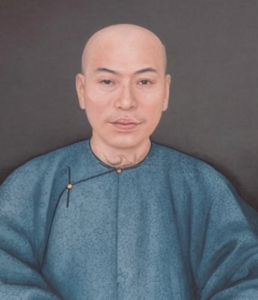
Wang Yuyou (1615-1684) was from Xincheng county, Baoding prefecture. Born into a noble family he studied both scholarly and martial arts, his father Wang Yanshan would teach and also invite different masters/experts. Wang Yuyou first studied with Lu Shan from Dingxing and later under Sun Qifeng from Rongcheng. He also became mutual friends and mentors with Mao Yuanyi, Du Yue, Diao Bao and others. Unfortunately Wang lived in the Military turmoil at the end of the Ming dynasty. When Li Zicheng was on the brink of overthrowing the Ming dynasty, Wang Yuyou, his father and some martial brothers fought across the counties in Baoding to protect the land and maintain the Ming empire. During that period of calamity that led to Li Zicheng’s reign lasted no more than a year (Shun dynasty 1644-1645), after which the Manchurians could take advantage of the weakened position through the civil battles to takeover and establish the Qing dynasty.
After all those battles, Wang dedicated himself to writings of history, military strategies, martial arts and philosophy. Wang Yuyou had a great influence on the Yan-Li School. Yan Xizhai studied with Yu You when he was 30 years old. Because he obeyed his knowledge of integrity, he always served Wang’s father. Afterwards, he and his disciple Li Shugu visited Yu You in Hejian, Xianxian and other places many times. In terms of economics and the study of applying the world to the world, they were very much in touch. Wang Yuyou likes to talk about the military and is skilled in fighting. He has written martial arts books such as “Thirteen Swordsmanship” and “Boxing”. The Yan-Li School advocated the study of both civil and military, and both Yan Xizhai and Li Shugu could practice martial arts, which is inseparable from the influence of Wang Yuyou.
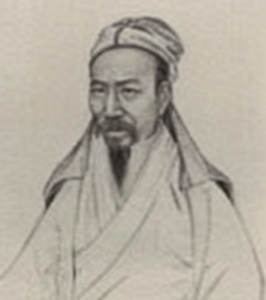
Li Shugu (1659-1733) , also known as Li Gong was from Li county and a disciple of Wang Yuyou and Yan Yuan (1635-1704) founder of the Yan-li school which emphasized practical experiences or science (实学) expressing that theoretical concepts needed to be balanced with the circumstances, where principles only make sense when applied and are subject to adjustment accordingly. With this mindset the importance of physical training was equal to developing the mind. Martial arts were an important part of training, fitness and self-cultivation.
Li Shugu expanded Yan Yuan’s theorem of the coherence between principle and matter and explained that the Heavenly principle was to be found in all things, and that without things there would be no principle. Li Gong traveled a lot as a kind of “visiting scholar” to propagate the teachings of Yan Yuan. The concept of Wen/Wu (Culture and Martial Arts) is on that basis and since Li Shugu would roam around different parts of the country he both had to defend against bandits enhancing his martial arts but also learn about the human condition under different contexts.
Many of the weapons methods in Chuojiao (and other Baoding prefecture martial arts like Bafanquan and Ma family Boxing) are descendent from those of Wang Yuyou and Li Shugu.
Bagua Jiao (8 Trigrams Order)
The white lotus movement has a very long and complex history within Chinese society. It has been active for a very long time, transforming itself in innumerable ways. Some of the different episodes, branches or conventions of the White Lotus/Bai Lianjiao include Jiu Gong Jiao, Bagua Jiao, Songhua Hui, Baiyang Jiao, Hongyang Jiao, Qingyang Jiao, Qingshui Jiao etc. We cannot outline its whole history here, so we will explain the relevant elements for the connections with Chuojiao. It should also be understood that the Ming dynasty founded by Zhu Yuanzhang, who himself was a member of the White Lotus (thus the use of Ming Wang, Ming Wu and Ming Dynasty). Whilst activities were surpressed during the Ming, after the Manchurians established the Qing dynasty, these sects and rebellions continued. Often the military heroes of the Ming dynasty became the leaders and later Matyrs of the Rebellions during the Qing.
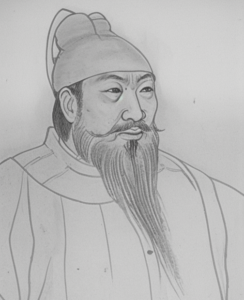
Liu Fengtian (1617-1693, real name was Li Tingyu, also known as Liu Zuochen) was a follower of the Daoism and during the years of the Qing Emperor (1644-1662) he set up his own sect of Bagua schools and had five Daoist schools around his hometown in Shandong province and taught many people but only accepted eight great-disciples, also known as the 8 Bagua: Gao Yunlong (Li Gua), Guo Tuyuan (Kan Gua), Chen Nanxing (Xun Gua), Zhang Zhaoxiang (Zhen Gua), Ji Yixue (Qian Gua), Liu Xingbang (Kun Gua), Qiu Zhifeng (Dui Gua), Wang Guoqing (Gen Gua), collectively referred to as “Bagua Zhenren”.
Liu Fengtian was a fascinating character and lived during very turbulent years during the end of the Ming dynasty and the start of the new Manchurian Qing dynasty. There are many interventions during the battles of those times. There was a very notorious Ming dynasty military officer Wu Sangui, who was battling the rebel forces of Li Zicheng trying to overthrow the Ming empire, as well as resisting the Manchurian attack. The difficulty of battling with Li’s rebellion and the Manchu’s at the same time led to the eventual fall of the Ming empire. The battles in those times would rage among Ming military, Qing armies, and peasant rebellions. Those were dark times and Liu Fengtian sought to resolve the issues with the peasant rebellions to reduce the blood shed.
Liu Fengtian was invited to the capitol in Beijing but brought all eight of his great-disciples along. After Liu Fengtian’s death his son Liu Ru took over his school. While Gao Yunlong divided his own school into two schools in Henan and Shandong. Liu Fengtian would have his students follow the Daoist practices every morning called the “Zhen Kong” (True Empty), and learn Ba Zi Zhen Jue (True Secrets of the Eight Characters). Liu is also acknowledged in a number of martial arts (as many were influenced or derived from the Bagua Jiao).
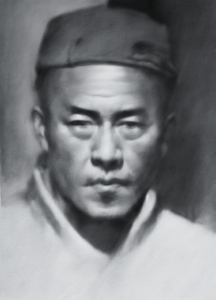
Gao Yunlong (Li Trigram Elder) would later change his teaching name to Gao Nanguo. Legend says he’s a descendant of Zhao Kuan Yin (Song Tai Zu emperor(927-976)). The family had previously gone with the surname of “Song” but had later changed it to “Gao”. Before he entered the Bagua Religion school he was proficient in the martial art of 32 Pattern Long Boxing, Hong Quan. Gao Yunlong achieved the Dao and “Penetrated the Heavens to become a True Person” (Zhenren) and worked with Liu Fengtian to combine the Wen (Literary) Daoist material with the Wu (martial) and combine them into one single practice. They combined Hong Quan with the internal theories of using the Qi/ energy harmonized/blended with martial movements. Where one was practicing the external and internal movements to be in harmony and work like one unit. The martial art was also known as Wensheng Gong (Wensheng Quan). They joined their efforts and studied and researched to find a way where one could be both an extremely skilled fighter and become a Zhenren (True Person, the highest achievement in Daoism/ Enlightened),The exact birth and death of Gao Yunlong is unknown but the Li Trigram school is dated to the middle years of the second Qing Emperor (1661-1722).
Gao Yunlong had many disciples. Yang Si Hai (1714-1784) was an expert martial artist and led the Dui Gua. His disciple Du Hengxin (1756-1838) was renowned as well in combat where it was said from Nanking to Beijing, it all belongs to Du Family’s Army” and led the Qian Gua. Du’s martial arts are referred to as Bagua Jiao Men Quan or Bagua Quan (note this has nothing to do with the Baguazhang style). The lineage related here of the Li Gua, is that of his disciple Gao Defu who taught Gao Gong, whom in turn taught Wang Guang. In 1774, there was the Wanglun uprising, whom also practiced the martial arts considered a subset of the Bagua Jiao, known as Qingshui Jiao (Clear Water Teachings), they classified disciples under Wen (Scholarly) and Wu (Military) categories, they practiced the circulation of breathing, empty hand and weapons combat.
There is/was a lot of lineages and students of Guo Yunlong’s art ‘Li Trigram System/ Spirit Boxing’ and later known as Changshou Quan and now as Wensheng Quan. But these schools were involved in the Bagua Uprising of 1813 and played a major part in later uprisings even until the Boxer Rebellion of 1900. Due to the politics and betrayal of the Qing court, the followers of the Bagua Daoism and the various styles of martial art were essentially erased from history and anyone who had survived the retributions did everything they could to distance themselves from the school/teachings of Bagua Jiao.
Tianli Jiao (Heavenly Order)
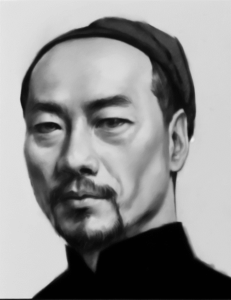
Feng Keshan (冯克善, 1776~1858), was born in Hua County, Henan province. Few have as complex as mysterious and complex an identity as Feng Keshan. Feng was said to have studied a multitude of martial arts since his youth; he had a natural talent and could acquire the essence of both letters and combat quickly. His father was a trader and able martial expert necessary to move products around the central plains, who was associated with martial arts experts regularly. In this manner, Feng was exposed to his family martial arts (Taizu Hong Quan) and obtained instruction from a large number of masters who were invited to tutor the household. Given his skills at the time, during his adolescence and young years, Feng Keshan was a ruffian, often involved in quarrels, fights, and troubles within the community, yet he matured and acquired quite a following. This later led to an interest in his skills and qualities by rebellious leaders.
Martial Arts Influences: In the records of the Song family from Shandong, the Bafan Men and Shaolin Muzi Quan was acquired by Feng’s earlier teacher, known as M Wang (most likley Wang Xuejun) from Hejian. It also denoted the main teachers growing up as M. Wang, M. Liu and M. Yang. By the time he was 21 he was an accomplished martial arts expert. In 1797, he became a disciple of M Wang Xiang from Rencheng (today’s Jinning, Shandong), in 1801, he also became a disciple of Meihua Quan M Tang Hengdong from Hua County (Huaxian, Henan).
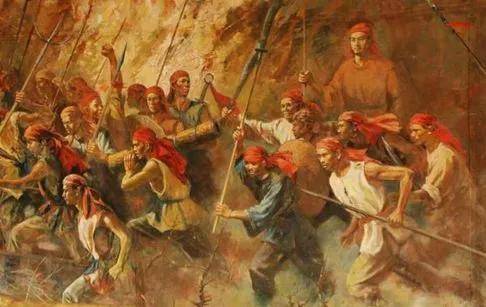
As his teacher, Wang Xiang was a well-respected and capable boxing master, as well as a prominent figure in the Bailian Jiao (White Lotus) derivative of Tiandi Men (Heaven and Earth Gate), which became Bagua Jiao under Liu Fengtian. Wang Xiang became the lead of the Li Gua of the Bagua Jiao (laeter unite temporarily as Tianli Jiao, 天理教- The Heavenly Order). Feng Keshan was cousins with Li Wencheng and was introduced to Lin Qing, then became the leader of the Li Gua (Trigram). However, after his teacher’s death in the 4th month of 1813, Feng Keshan became disinterested in the Uprising plans and abandoned the cause. “Official Qing government records indicated that Feng Keshan was executed by the Qing government in 1814“, but this was common practice to proclaim the death of rebellious leaders to demonstrate success over rebellions.
Master Feng Keshan’s earlier students in 1811, were Song Yulin and Song Yuelong in Dezhou , whom had joined the Li Trigram division of the 8 Trigrams Sect. After Song Yuelong having lost a duel with Feng Keshan his followers all were to join the Li Trigram. They were recorded as having studied the Liu Tang Gen methods from Feng Keshan. In 1813, the Uprising failed and it is said that Feng was captured awaiting in Xian County Prison before execution. With assistance from fellow colleagues, Feng and others managed to escape. According to the confession of Feng’s disciple Song Yueyang in the “The Chronicles of the Qin Ding Ping Ding Jiao Bandits” official chronicle of the Qing Dynasty. It records the Tianli Sect from September 12, the 18th year of Jiaqing (1813) to the third day of June, the 21st year (1816) it states from Song that ” Feng Keshan “then broke out straight away, ran to Nanguantao, and spent the night in Hewanzi. Crossing the river at dawn on the 24th, it was his junior brother Zhao Laosi that prepared boats. After crossing the river, they went to Zhao Laosi’s house in Dongdianzi Village and stayed there for three days. Due to blood stains, they had to remove their clothes and boots (threw them in the river), as it was difficult to ride a horse and carry weapons/equipment, they handed over those to Zhao Laosi. Feng borrowed Zhao Laosi’s clothes, shoes and socks, and wore a fox mantle that he used to saddle his horse. On October 27, he got up at Zhao Laosi’s house.” Feng Keshan’s junior brother Zhao Laosi (Zhao Laocan, Zhao Canzhang) s mentioned here. In essence, Feng often took up his younger brother/disciples alias, where as often when it is exclaimed as Zhao Laocan, who travels around Hebei to teach boxing, is probably Feng Keshan’s junior brother Zhao Laocan.
After the fall of the Jiaqing Emperor (reigned from 1796-1820), Feng Keshan then headed to Zhaoduanzhuang in Lixian (Li county), northwest from Raoyang. There he stayed with Liu Shang, a fellow martial arts colleague and head of the Liu family household. Liu had taught Luohan Quan, Liuhe Quan and Taizu Quan to his three sons. Then he invited Feng keshan (Chuojiao), Yang Jing (Taiji 13)) and Tang Youyi (Ditangquan). They taught the Liu family and close acquaintances for an estimated 10 years.
The boxing methods encompassed within Chuojiao actually are the different combined efforts of Feng Keshan, his associates, military personnel and disciples across of each of the areas in particular Raoyang and Li County. Feng Keshan respected as the founder not always because he was directly the teacher, but rather as the leader of the Tianli Jiao at the time. The collective practiced a large array of boxing methods with Bafanquan as a core including Jingangquan, Wenshengquan, Erlangquan, Liuhequan, Chuojiao, Taiji 13 shapes, Luohanquan, Taizuquan, Ditangquan and specialized weapons systems too. It is a collective and not a martial art of just one founder.
The collective development of Chuojiao Men
Each of the areas in which Chuojiao is practised has a variation as to their respective lineages. Since they include both the methods from different experts, as well as local based empty hand and weapons combat systems. The legend tells of the story where Duan Luoxu, Liu Shang, and Zhang Jingxu had combined efforts to save Feng Keshan. They were members of the Bagua/Tianli Jiao but were not involved in the siege on the capital. Feng Keshan was saved by Zhang Jingxiu, Duan Luoxu and Liu Shang. They had found him in a cell located in Xian county (neighbouring Raoyang) in preparation for execution. Duan knew the Liu family had contacts and could bribe the guards, together they conspired to save Feng. Thereafter since the then Jiaqing emperor was still actively seeking anyone associated with the Tianli Jiao (Bagua Jiao) uprising, Feng kept a low profile in Raoyang areas.
The key contributors of Chuojiao included many and we will highlight a few here:
Liu Shang, also known as Liu Guiyan from Li county, was a practioner of Cangzhou Liuhequan and Hejian Taizuquan, and taught the Liu brothers since young so that the eldest learnt Luohanquan, the second learnt Liuhequan and the youngest learnt Taizu Hong Quan. The Liu family at the time were merchants and owned significant land, as a result they had established teachings for their family in the Zhaoduanzhuang village. Each of the Liu brothers achieved different levels of success. The eldest became a part of the government, whilst Liu Guanlan in addition to the family trade also ran a successful Fuyuan Security Logistics Bureau.
Zhao Laocan, Zhao Canyi (1795-1876),ie Zhao Youyi, one of Feng’s associates that he encountered after teaching Raoyang (Yaoyang). In different villages like Feng Zhuang in Shen County (Zhang Jingxiu’s hometown) it was said that Shaolinquan and Bafanquan were taught, noting that Zhang was a Bafanquan practitioner. In Beiguanzhuang of Raoyang it is said that Zhao Canyi (Zhao Bafang) taught Jingangquan (related to Shaolin Muzi Quan and Bafan Shou). As it is normal sometimes two generations are teaching simultaneously so it is not a direct method but one of multiple contributions, often leading to differences in lineages. Zhao was for a time involved in Security logistics, in the Zhenyuan Biaoju and Wansheng Biaoju bureaus. Zhao Bafang had also participated in the Taiping Tianguo uprising under Li Kaifang (a general under Shi Dakai), returning afterwards, he taught the key generation of Raoyang Chuojiao.
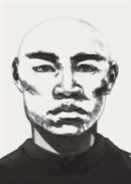
Yang Jing (1789-1856) was a young yet talented officer of the Bagua Jiao. His great grandfather was originally from Shanxi and then moved the family to Shandong. The Next generation then moved to Heilongjiang. As a teenager he registered under his ancestral home in Shandong and then joined the Bagua Jiao in Dezhou, Shandong.
Yang Jing learnt his family martial arts (which had influences from old Xin yi and Zimen Quan) and also enhanced his skills with different members of the Li Gua faction. His skills were later to be known as the Xinyi Taiji Shisan Xing, or Hard Taiji 13 animals of Chuojiao and the Gu Wudang Quan, or Soft Taiji of Chuojiao.
After the 1813 uprising, Yang Jing became a monk in hiding and later Liu Shang invited him to teach in his home (Zhaoduanzhuang, Li County, Hebei Province). He returned to his family home in Heilongjiang, where he passed on his martial arts and it became known as Yang Family Eight Palms, among other names.
Zhang Jingxiu (1815-1895) was from Fengjiazhuang, he studied with M. Feng Xiaosheng, the methods of Bafanquan’s Babu (8 Steps) were passed down from here including Luomen Babu, Ruan Babu and Ying Babu. Zhang later followed Feng Keshan or Zhao Canyi and developed the system from being originally known as Bafanzi quan, then later called Chuojiao dai fanzi, he had over 800 followers in fengjiazhuang.
Tang Youyi (1787-1851) was one of Feng Keshan’s commanders in the Bagua uprising and an expert of Dixing Quan (or Ditang Quan). Tang learnt Ditangquan in Deping county, Shandong province. He later joined the Tianlijiao in Dezhou. M. Tang originally passed on the Dixing methods, including their weapons sets like the Ditang Saber and flexible weapons (like the throwing dart, chain-whips and combinations thereof).
Zhou Laoting was a pracititoner of Huaquan, that taught in Raoyang, when Feng Keshan saw his large following, he encountered Zhou and after being defeated, Zhou became a follower of Feng Keshan and his students a part of the system. This imparted the Hua Quan methods into Chuojiao.
Wang Zhiguo was also practitioner of Bafanquan, of the Li Gong lineage. He originally operated a Logistics Security Bureau (Yongshun Biaoju) in his hometown but it became bankrupt. As a result Wang traveled up and found work as a teacher for different households and eventually joined the Liu family Fuyuan Biaoju. There boxing was exchanged between Chuojiao and his Bafanquan. Wang’s son also became manager of the Bureau eventually but following a dispute with Liu Guanlan, some problems ensued. In any case, this brought further Bafanquan methods into Chuojiao (such as Cui Bafan, Qingshou Fan etc).
The different branches/descendants of Chuojiao
Raoyang (Yaoyang) Chuojiao
The younger generation of disciples under the guidance of Feng Keshan/Zhao Laocan included Duan Yongqing and Duan Yonghe, Zhou Laoting, Jia Laokai and Wang Laoyuan. Historically in Raoyang, from Zhao Laocan, there were 10 notable teachers of the second generation (Ji Laohong, Cao Zhizhong, Zhao Laozhi, Zhang Sibao, Zhang Laoxiao, Zhao Laoxian, Li Laoti, Li Laosui, Shen Laokai and Liu Laowang).
Zhang Family Chuojiao 饒陽张氏戳腳: Zhang Laoxiao, was a martial brother of Li Laosui, and studied under Zhao Canyi. Zhang had many disciples. The 8 Brothers of the third generation became the most well known and were all from Beiguanzhuang, and all were disciples of Zhang Laoxiao.
Li Family Chuojiao 饒陽李氏戳腳: Li Timing also had numerous disciples and his skills spread throughout the villages. In Shen County, there was Wang Yuetong and Han Qichang. In Beizhangbao village, Li Fushan, Li Ancheng, Zhao Biao. In Zou Village, Yang Kuishan. In Wangqiao village Wang Chenzhang. In Yuanzi village, Zhou Jinhui and others.
Song Family Chuojiao 饒陽宋氏戳腳: Song Laoqian, a disciple of the Duan brothers taught his descendants and the style has now been taught across Hengshui.
Zhang Sibao, was prosecuted as a criminal for his rebellious actviites and therefore had changed his name to Zhang Degong, escaping to Wuqing county around Tianjin,teaching there in 1850s. His key discipled was Li Kuiqing.
Lixian Chuojiao
Feng Keshan after his time in the south (Raoyang) moved to Lixian. There were further developments and methods at that time and many new techniques were created. Since his personnel from his former days such as Tang Youyi and Yang Jing also contributed, Chuojiao became well established as a formidable martial art. There are also other possibilities where practitioners from Raoyang had also influence other lines in Li County .
Liu Family Chuojiao 蠡縣劉氏戳腳: These are the practitioners descended from Feng Keshan’s disciples the Liu brothers, Liu Guanlan (1814-1903) in particular, spread the art in their county and elsewhere (as they worked in security escort business). Lixian Chuojiao was the most widely spread. It is in fact the Liu family that consolidated the skills from their family (Luohanquan, Taizuquan, Shuaijiao & Liuhequan) as well as Tang Youyi (Ditangquan), Yang Jing (Taiji 13 shapes), Wang Zhiguo (Bafanquan) and Feng Keshan (Chuojiao) into a complete system.
The Wen Tangzi of Chuojiao were completed by Liu Guanlan (just a collection of different martial arts he studied). Therefore Liu Guanlan is respected as one of the key ancestors of Chuojiao. Feng Keshan and Liu Shang had sent a note for Liu Guanlan to work for the Chengxing Bureau in Cangzhou where Da Liuhe Men expert Li Fenggang was the head (Liu Shang had studied Liuhequan). There Liu Guanlan studied further but also learn the Security Bureau business. Later he established the Fuyuan Security bureau which helped spread the boxing skills far and wide. The Fuyuan Bureau hired mostly Chuojiao and related practitioners from Liu’s hometown, at that time Wang Zhiguo from a nearby county in Li county had established a bureau but later closed down. His son Wang Zhan’ao joined Liu’s Fuyuan bureau and after Liu retired managed it as well, it is there that many branches/derivatives of Chuojiao rose. Liu Junjie (Liu Guixin) was the brother of Liu Guanlan and he passed Chuojiao within the family in Zhaoduanzhuang, especially Liu Zhenguo who maintained the Chuojiao methods onto next generations at its home. It is noted that whilst Liu Guanlan taught and exchanged with many, he had passed all his key skills only to the Liu family (Zhen generation) and key Deyi disciples: Zhao Zhenji, Liu Zhenjiang and Ran Zhenji. They each taught in neighboring villages where Chuojiao had been propagated comprehensively.
Wei Style Chuojiao 蠡縣魏氏戳腳:
Wei Luofang (1808-1885) from Nanliu had a significant following as he managed a security logistics bureau as well and many would absorb remnants of Chuojiao and teach in their villages. Some of these include those from Boye county Geng Aichang, Zhao Laoduo, Zhang Xiu and Gao Laochao; from Zhuozhou country Xing Laohai, Cai Yin; from Li county Liang Zhuang (1819-1911) and He Zhenjiang.
Chuojiao Fanzi /戳脚翻子/御翻子
Wei Changyi (1812-1910) was the cousin of the Liu family and he later also joined the Security Bureau business with the Liu family. He later taught in Qi county, including his nephew Wei Zankui (1854-1951) and his Deyi disciple Wang Luocang who also became a security officer then later taught in Zhuzuo Village.
Wei Zankui had served as a security officer and imperial guard, achieving a high rank for fighting against the eight alliance forces and protecting the Empress Dowager, his boxing was also called in honour as Yu Fanzi (Imperial Fanzi). He latter taught many different disciples such as Wei Xing, Wei Youcai, Wei Xishen, Wu Zhentang, Wu Binlou, Xiao Chunro. In Beijing, a renowned expert from Qi county, M Wu Binlou, disciple of Wei Zankui, established chuojiaofanzi in the capital.
Gaoyang Chuojiao 高阳赵氏戳腳:
Gaoyang is just north neighbouring Li County, in its southern areas there are many villages known for martial arts predominantly Duanquan, Bafanquan, Yanqingquan and Taizu Hongquan. Descendants from Zhao Zhenji, Liu Zhenjiang and Wang Luocang later brought the Chuojiao system and integrated it with the local methods. In addition Zhao Fupan from Raoyang Chuojiao and Wang Zhan’ao from Bafanquan had descendants in Gaoyang as well.
Suning Chuojiao 肃宁尹氏戳腳:
Yin Baisui and Yin Guifang were from Bianjiawu village in Gaoyang, whom had partially studied Gaoyang Chuojiao (which includes Duanquan, Taizuquan, Bafanquan and Chuojiao) then taught some of the methods in the Houbaisi village. Yin Ruyan also from Houbaisi village, taught Yin Bingwu and Yin Xuejie. Yin Xuejie taught Zhang Hong who called the practice ‘Gu Zhizi’. Yin Bingwu, in addition to learning from his father, further studied Chuojiao with Liu Renyi (Li county Geng village). Miao Xiaolan was Yin Bingwu’s student, and later she further studied with Liu Qingpo (Liu Renyi’s son).
There are many other lineages spread far and wide across Hebei province and beyond. Resultant from both the variety and non cohesive teaching methods of M Feng Keshan or that first generation series of coaches, coupled with the skills from other styles that were held in some of the key disciples it has resulted that there are a few different variations. In general though, these variations are but stylistic and the core are still in common among the styles. It should be noted that before Feng Keshan arrived, many styles were practiced in the area (Li County, Gaoyang County, Sunning County etc) thus were absorbed into Chuojiao as well. The Baoding prefecture is well known for being the source of many great military leaders and has historically been a centre of martial arts excellence, there are styles such as Bafanquan, Taizu Changquan, Xixia Quan, Ma family Quan, Luohan Quan, Xinyi Taiji Xing Quan, Mianzhang, Ditang Quan, Cha hua Quan, Duan Quan, amongst many others – many of these had been incorporated into Chuojiao overtime.
In addition to the different branches of Chuojiao, there are also derivations where parts of chuojiao were learnt and then mixed further or that only remnants of the overall style evolved in other locations. Some of these include the following :
Yangzhou Chuojiao 扬州戳腳- Zhang Family Chuojiao 張氏戳腳 – Zhang Hengqing was from the Duliu village of Jinghai, he studied the local boxing system of Taizu Tongbei Quan , which is known for its 24 Tongbei methods and the Miao Dao. Later, he also learnt some Chuojiao, gaining the reputation as iron legs Zhang. In 1890 until 1913, he relocated and worked in the Green Forest Security Bureau in Yangzhou. In order to train his guards, he consolidated the single combination methods of Tongbei and some chuojiao techniques into a distinct system of Yangzhou Chuojiao. His main disciples included Wang Qing Fu, He Yu Shan, Tian Chun and others.
Tianjin Chuojiao 津門戳腳 – Was taught by Han Yixiang (1906-1981) who was originally from Gaoyang County, was said to have studied with Wang Zhan’ao. In 1926 M Han moved to Tianjin and being young he continued studying other arts such Yingzhao Quan from Cao Qingfeng, old shaolin boxing from Guo Fushun. In the 1950’s he held many official positions
Digong Chuojiao 地功戳腳- Gao Family Chuojiao 高氏戳腳 -In Shenyang a master from Li county by the name of Gao Bai Quan passed on a Chuo jiao style named “Di Gong Chuo Jiao” (Ground Skill Chuo Jiao). Master Gao was born in Li county and commenced the practice of Chuo Jiao at the age of 11 under master Wang Yong Cen (a disciple of Wei Lao Fang).
Dongbei Chuojiao 東北戳腳 – Xu Family Chuojiao – Xu Zhaoxiong, was a student of Wang Zhanao (from Gaoyang County, Son of Wang Zhiguo and disciple of Wei Laofang, part of Liu Guanlan’s Logistics Security Bureau) studying bafanquan and chuojiao. Master Xu brought his Chuojiao/fanzi methods and propagated the art in Dongbei areas (Liaoning etc). This is also known as Dongbei Chuojiao Fanzi.
Hu Family Chuojiao 胡氏戳脚 – Hu Feng San, nicknamed “Hua Qiang Hu” (Flower Spear Hu) for his command of the spear, was a master of other martial arts (Shaolin, Xingyi etc) prior to studying some elementary Chuojiao. He created and taught his Hu Family boxing, later known as sequences of Wen Tang Zi (Scholarly Sequences) to students in the city of Shenyang in Liaoning Province. These are new creations that include other martial influences not specifically related to the Chuojiao Wen Tangzi from Li county. Since Hu Fengsan later was friends Yang Junfeng and Hao Mingjiu (student of Xu Zhaoxiong) and their combined efforts was called Chuojiao Fanzi, also known as Dongbei Chuojiao.
The above are basically the specific Chuojiao branches, additionally there are also styles which have incorporated or combined with Chuojiao such as: Chuojiao Tanglang (Chuojiao Praying Mantis), Shuihuquan (水滸拳 Water Margin Boxing), Ma Shi Tongbei (馬氏通备 Ma Family Tongbei), Chuojiao Dai Fanshou (戳腳帶翻手Chuojiao with Rotating Hands), Yuanyang Tui (鴛鴦腿 Mandarin Duck Kicks), Ditangquan (地躺拳 Ground Tumbling Boxing) and others.
Empty Hand System
Taiping Chuojiao encompasses practices from Shenzhou (Y/Raoyangxian) and Baoding Chuojiao (Lixian, Gaoyangxian). Over the years we have researched/studied many different branches of Chuojiao and have adopted some of those as well. Chuojiao demands the full use of all parts of the body and as a result one of the key fundamentals is to develop coordination and flexibility to the same. When commencing the study of Chuojiao one commences with specific exercises to strengthen the structure of the body, which includes both strength but pliability development as well. All the joints need to be highly tuned to ensure proper absorption. The preliminary methods of Chuojiao focus on some unique kicking fundamentals. Additionally, basic stances are developed including unique Zhanzhuang (Standing Post Exercises) methods. From here some introductory drills (both individual and partner) are practiced ranging from the obviously simple to more advanced. At this stage some of the key stepping methods, combinations and hand works are introduced.
Jiben Gong Fa/基本功法 – Fundamental conditioning and training exercises
As Chuojiao requires all aspects of the body to be applied, the conditioning is a thorough program of gaining strength and flexibility across all major parts. To achieve this there are many isometric and calisthenics like exercises that are practiced, these are divided into a few major categories.
- Zhuang Gong Fa (Static stance and standing meditation methods))
- Ti Zhuang Fa (Static Kicking or Leg strengthening Postures)
- Di Gong Fa (Ground Strengthening methods, upper limb strenghtening)
- Tui Gong Fa (Dynamic Kicking or Leg Strengthening Movements)
- Yao Gong Fa (Waist, back and abdominals development)
- Kao Da Fa (Body bumping, striking, development)
- Huo Bu Fa (Stepping and Footwork development)
- Die Pu Fa ( Falling and Dropping onto ground)
The exercises and methods above are supported by other fitness approaches, to provide the basic development of the physique to be able to study further within the Chuojiao system.
Liu Tui Shi/溜腿势 – Fundamental kicking practices
The practice of standalone kicking methods are both treated as exercises and practice, with emphasis on gaining flexibility and strength. Many of these are as a result high based kicks. Liu Tui means to let the legs smoothly move, in the old days most martial arts would have a foundation set of Liutui Shi which combines kicks in al directions for strength and dynamic flexibility whilst also practicing different types of fundamental kicks. In Chuojiao, having such a large array of kicks this is an important foundation.
Dan Cao/单操 Shou Tao/手套 – Techniques and methods practices
The practice of standalone techniques. These form important basics and develop the coordination and techniques. These are not single techniques in terms of movement rather they encompass an range of methods. As a result for example Wu Hua Pao can be practiced as 3 step variation or a 6 step one, as well as with different footwork (there are 12 main variations of Wuhua Pao). Liu He Shou as an example includes techniques in short and long, from a turn or stationary variations. Actually many of these independent techniques and drills were common to the Zhili area, thus there are crossovers with the various systems.
In addition to the standalone techniques, Chuojiao also includes the practice of fundamental drills that range from conditioning of the body and limbs by knocking with an opponent but then advance into more complex yet practical combat techniques practice.
In Chuojiao applies the use of apparatus to aid in the process of training and conditioning, as well as for techniques practice. These include poles, logs, posts, sandbags (multiple, stationary and moving setups), iron bags, pads, boulders and many more which develop the necessary power, impact skills and evasive methods.
Art the heart of Chuojiao lies the study of many methods including the 5 elements, six coordinations, 9 keys, 81 kicking methods, changing and transforming hand methods, energy generation methods and much more.
Some of the key principles of legwork (kicks) of Chuojiao include the following: – Dian (点,Point) – Quan (圈,Circle) – Jue (觉,Trample) – Nian (粘,Roll) – Cuo (搓,Grind) – Ti (提,Lift) – Cun (寸,Inch) – Xian (掀,Cover). – Cha (插, Pierce) – Bai (Swing, 摆) – Ti (kick, 踢) – Deng (Stomp, 蹬 )
In Chuojiao: – Hands and legs can be used simultaneously yet mutually exclusive from each to take advantage of the full arsenal of the human body. – Every plane from upper to lower and middle can be transitioned with ease and methods can interchange accordingly.
Chuojiao System of Practice
Chuo Jiao is a battle-oriented martial art that requires the training of many drills and combat. With a martial containing the content and having the long military history of Chuojiao, it is noticeable that there are quite a lot of methods passed down that encapsulate concisely many of the theorems and techniques into a practice method. Once students have mastered the basic exercises, gong, methods, and drills, they must firstly learn and practice the individual techniques, which includes their basic application and mastery of the techniques to an acceptable level. These are composed and the form or routine is taught in full, at which time further applications, power methods and technical aspects are refined.
Chuo Jiao is a battle orientated martial art which requires the training of many drills and combat. With a martial containing the content and having the long military history of Chuojiao, it is noticeable that there are quite a lot of methods passed down that encapsulate concisely many of the theorems and techniques into a practice method. Once students have mastered the basic exercises, gong, methods and drills, then to learn the forms students must firstly learn and practice the individual techniques, which includes their basic application and mastery of the techniques to an acceptable level. These are composed and the form or routine is taught in full, at which time further applications, power methods and technical aspects are refined.
Jingang Quan/金刚拳
| Wuhua Pao (五花炮 Cannon Strikes) Jingang Chui (金刚捶 Jingang Strikes) Sixing Quan (四型拳 4 Shapes) | Babu Quan (软八步拳 Soft 8 Steps) Babu Quan (硬八步拳 Hard 8 Steps) Zixu Quan (子胥拳 General Zi Xu) | Mian An Quan (棉安拳 Mian An) Lishi Quan (金刚力士拳 Lishi) Shoutao (手套 Combat Drills |
Taizu Quan/太祖拳
| Siping Chui (四平拳 Four Level Boxing) Meihua Pao (梅花炮 Plum Blossom Cannon) Xiao Taizu (小太祖拳 Taizu Boxing) | Da Taizu (大太祖拳 Taizu Boxing) Xiao Hong Quan (小红拳 Small Hong Boxing) Da Hong Quan (大红拳 Large Hong Boxing) | Gougua Tui (钩挂腿 Hooking Hanging Kicks) Fanbei Chui (翻背捶 (Turn the back strikes) Wuhu Quan (五虎拳 Five Tigers Boxing) |
Chuojiao /戳脚 (文武趟子)
| Jiu Zhi Zi Quan (九枝子拳, 9 Sequences branches) Yu Huan Bu (御环步 Royal Step) Lian Huan Quan (连环拳 Continuous Fists) Lian Huan Tui (连环腿 Continuous Kicks) Rao Ma Tui (绕马腿 Round Weighted Down Kicks) | Shi Ba Ti (十八腿 18 Kicks) Shi Ba Dian (十八点 18 Points) Cha Dian (插点 Stab Vital Points) Li Shi Quan (力士拳 Guardian Warrior Boxing) San Lan Shou (三拦手 3 Intercepting Hands) | Yuhuan Bu (玉环步 Jade ring step) Jia Zi Tui (甲子腿 Jia Zi Kicks) Jia Zi Chui (甲子捶 Jia Zi Strikes) Zhuan Huan Lian (转环连 Turning Ring Continuous) |
Fanzi Quan/翻子拳
| Cui Bafan (翠八翻 Through Rotations) Qing Bafan (清八翻 Clear Rotations) | Cun Bafan (寸八翻 Inch Rotations) Yuebu Chui (跃步锤 Spring Step Boxing) | Babu Jinchan Shen ( 紧缠身 Entanglement) Nezha Quan (哪吒拳 Nezha Boxing) |
Meihua & Bagua Quan /梅花拳与八卦拳
| Xiao Mei Quan (小梅拳 Small Blossom) Lianhuan Zhang (连环掌 Continuous Palms) | Bafang Zhang (八方掌 8 Coiling Palms) Bafa Quan (八法拳 8 Methods) | Bapan Tui (八盘腿 8 Coiling Kicks) Bagua Quan (八卦拳 8 Trigrams Boxing) |
Yanqing Fan & Luohan Quan/燕青翻与罗汉拳
| Liuhe Quan (六合拳 Six Harmonies Boxing) Liuhe Tui (六合腿 Six Harmonies Kicks) | Yanzi Quan (燕子拳 Yanzi Boxing) Yanqing Fan (燕青翻 Yanqing Rotations) | Luohan Quan (羅漢拳 Luohan Boxing) Luohan Ying (羅漢影 Luohan Impression) |
36 Interlocking 温家三十六合锁
The Locking hands of Chuojiao, are methods of Chin-na (Joint manipulations) seizing, grappling and controlling techniques. Since each lock has three derivations (Lock and counter-locks), it is sometimes known as the 108 Chin-na methods of Chuojiao.
Taiji 13 Shapes /太极十三形
Chuojiao’s Taiji bares no resemblance to what is typical taijiquan in modern times. This ancient system includes softer methods and then harder ones with releases of power, smooth transitions and whole body projection, as the methods passed on by the teachings of Yang Jing. There is also single practice methods with visible Bo fa li (explosive power releasing). Training with apparatus such as the heavy ball (Taji Qiu ) and specific wapons were also passed down by Yang Jing. The Shisanxing (13 Shapes/Imitations ) are represented by the 13 animals of Dragon, tiger, monkey, horse, crane, rooster, bear, swallow bird, camel, leopard, eagle, sparrow hawk and snake.
| 劈太极 Pi Taij (Hard energy) (13 Animals) 化太极 Hua Taiji or Rou Taij (Transformative Gentle Energy) |
Meihua Luodi /梅花落地 (Ditangquan /地躺拳)
Attacking angular strikes, kicks, hidden movements of tumbling, falling and Ground fighting are a major focus of Meihua Luodi (or Ditangquan). These techniques were derived from the teachings of Tang Youyi.
| Dixing Quan (地行拳 Ground Moving Boxing) Zi Sun Dan (子孙丹 Posterity Elixir) Fei Jian (飞剪 Flying Scissors) | Wu Xue Jiao (五踅脚 5 single Legs) Jing Si Shou (金丝手 Golden Wrapped Hands) Yanzi Ka (燕子卡 Swallow Blocking) | Xiao Ba Xian (小八仙 8 Small Immortals Da Ba Xian (大八仙 8 Large Immortals) Zui Ba Xian (醉八仙 Drunken 8 Immortals Boxing ) |
Nei Gong Fa/内功 – Internal Cultivation Methods
Chuojiao absorbed the methods from the Daoist Quanzhen School and from the Buddhist Shaolin School in terms of nourishing and stimulating the internal organs. There are as a result a few different practices that are taught at various in the curriculum to support the requirements at the relevant time.
Hun Yuan Gong (混元功法 / Primordial Chaos Exercises) | Hun Yuan Gong consists of both seated and standing exercises, as well some Dantian nuturing methods including Yang Dantian (Nourishing the Dantian), Zhan Dantian (Holding the Dantian), Fan Dantian (Turning the Dantian) and so on. Whole body internal power development is then practiced through methods known as Yinyang Dafa (Balancing), yun bafa (Transporting) and Kaihe Dafa (opening and closing)
Taiyi Wushi Fa (太乙五十法/ Taiyi 50 Methods) | 50 Methods of Primordial unity of Yin and Yang: Also known as Dongyi (动意功, Mind moving) methods, these are advanced derivative practices of Nei Dan (内丹/Internal Elixir) Qigong.
Three Classics (三经) | One of the Chuojiao internal development methods are the three classics. These originate in ancient Daoist Internal cultivation techniques and have developed into comprehensive practice. It is said “If the fluids are well maintain, the spirit is good; If the Blood and Immune system are well, the body is fit and healthy; If the tendons and physique are well, overall longevity will be achieved
Shui Jin Jing (水津经 / Transformation of the fluids )
Xue Jin Jing(血筋经Transformation of blood & Immune System)
Yi Jin Jing (易筋经 / Transformation of Tendons & Physique)
Weaponry/器械
Practitioners of Chuojiao did not realm temples or isolated mountains, Chuojiao practitioners were warriors or knights, rebels and bandits. They served as Imperial bodyguards, battled in wars for the rights of the masses and were generals and fighters in uprisings and rebellions. Skilled in empty hand combat, yet masters of military strategy and chinese weapons. There are an enormous array of Weapons skills as a result. The key weapons of focus are the Spear (Qiang), the broadsword (Dao), the sword (Jian) and the Taiping Dao (Long Handled broadsword or Shuang Shou Dai). Other unique and rare weapons were also practiced and we thus continue the practical training of such. Some of the key weapons and their sets/methods are noted below:
Staff 棍
It is said that Chuojiao practitioners preferred the Spear – a weapon often used in battle. However the Wuhu Panlong (Coliing Staff) which is thought to have been brought in from the Taizu Hong Quan system, is one of the most comprehensive Taizu staff methods encompassing many of the best techniques from Northern Staff.
- Kai Shan Gun (开山棍 (一至三趟) Opening Mountain Staff)
- Yin Yang Suo Shou Gun (阴阳锁手棍 Yan and Yang Locking Hands Staff)
- Zi Mu Yuan Yang Bang (子母鸳鸯棒 Mother and Son Mandarin Ducks Stick)
- Wu Hu Pan Long Gun (五虎盘龙棍 (一至五路) 5 Tigers Coiling Dragon Staff)
- Da Lian Jie Shaozi Gun (大连节梢子棍 Large Link sectional Staff)
Broadsword /刀
Many of the Saber methods are from the Wang Youyi, whom had developed the continuous saber methods. and the double sabers from Pan Ziliang.
- Kun Lun Dao (大小昆仑刀) Kun Lun Broadsword)
- Jin Bei Dao (金背刀 Golden Back Broadsword)
- Bagua Dao (八卦刀 Bagua Broadsword)
- Meihua Dao (梅花刀 Plum Blosssom Broadsword)
- Liuhe Dao (六合刀 Six Harmonies Broadsword)
- Shuangshou Dai Dao (双手带刀 Double Handled Chopping Saber)
- Ye Zhan Ba Fang Dao (夜战八方刀 Night Battle 8 Directions Broadsword)
- Zhan Dao (Miao Dao) (战刀 Battle Long Broadsword)
- Shuang Dao (双刀 Double Broadswords)
Sword /剑
The sword methods of Chuojiao in folklore are said to derive from the best methods of ancient China – such the Hua Shan Pai (famous for its sword), as Wang Xiang was one of the keepers or key inheritors from the Hua Shan system. The Qimen Sword system is alongside Qingping and Wudang, one of the 3 great sword systems and it was from Sun family. The Yan-Li Scholarly school is also a key sources of sword methods within Chuojiao.
- Wen Wu San Cai Jian (三才剑: 文,武二路) 3 Treasures Sword)
- Zi Wu Jian (子午剑 Ziwu Sword)
- Qinglong Jian (青龙剑:青,行二路) Green Dragon Sword)
- Qi Xing Jian (七星剑 7 Stars Sword)
- Qimen Jian (奇门剑 (一至三路) Qi Men Sword)
- Qiankun Jian ( 乾坤剑 Qiankun Sword)
- Yanyan Jian (炎焰剑 Flame Sword)
- Shuang Shou Da Jian (双手长剑 Two Handed Long Sword)
- San He Quan Long Shuang Jian (三合圈龙双剑 3 Harmonies Dragon Double swords)
Spear /枪
In Northern China, the spear is considered the king of long weapons. There have been many famous methods throughout history such as the Lihua Spear from the Yang family, the Liuhe Spear, Yue family, Luo Family and Ma Family Spears. the Wu Hu (5 Tigers) refer the five families/styles of spear on which the methods are based. The Luosi (Flexible) Spear is quite unique to Chuojiao and rarely found in other styles.
- Zheng Ba Luo Si Qiang (正把罗丝枪 Straight Hold Flexible Shifting Spear)
- Er long Chu Shui Qiang (二龙出水枪 Double Dragons Exit Water Spear)
- Meihua Qiang (梅花枪 Plum Blossom Spear)
- Wu Hu Duan Men Qiang (五虎断门枪 5 Tigers Breaking the Gate Spear)
- Wu Hu Dian Gang Qiang (五虎点刚枪 5 Tigers Pointing the Hardness Spear)
- Zuo Ba Luo Si Qiang (左把罗丝枪 Left Hold Flexible Shifting Spear)
- Yin Ba Qi Men Qiang (阴把奇门枪 Inverse Hold Mysterious Spear)
- Yi Shou Si Men Qiang (易手四门枪 Changing Hands Four Gates Spear)
- Jueming Shisan Qiang (绝命十三枪, Life ending 13 Spear)
- Liu he Da Qiang (六合大枪 6 Harmonies Long Spear)
- Shuang Tou She Qiang (双头蛇枪 Two Headed Snake Spear)
Other Weapons
| Jiu Jie Bian (九节鞭 9 Section Whip Chain) Shisan Jie Bian (十三节鞭 13 Section Whip Chain) Dao Li Bian (刀里加鞭 Saber with Whip Chain) Huli Bian (狐狸鞭 Staff with Whip Chain) | Zou Xian Chui (走线锤 Flying Hammer on a line) Shuang Liuxing Chui (双流星锤 Rope hammers) Sanjie Gun (三节棍 Three sectional Staff) Fangbian Chan (方便铲 Monk’s Spade) |
| Hu Tou Shuang Gou (虎头双钩 Tiger Head Hook Swords) Shuang Ji Zhua (双鸡抓 Twin Chicken Claws) Shuang Tang (双镗 double tridents) Yuan Yang Pen (鸳鸯盆 Mandarin Duck Basins) Hushou Guai (护手拐 protecting crutches) Bi Shou (匕首 double daggers) | Lu Jiao Gou (鹿角钩 Deer Antler hook swords) Dao jia Qiang (刀加枪 Saber with Spear) Meihua Shuang Ce (梅花双刺 Double Piercers) Nezha Jin Huan (哪吒金环 Nezha Ring) Yuan Yang Chan (鸳鸯铲 Mandarin Duck Hook Knives) Pu Dao (扑刀 Long handled long blade) |
| Hu Wei Bian (虎尾鞭 Tiger Tail Hard Whip) Qing Feng Da Dao (清风大刀 Clear Wind Long Saber) Long Xing Tang (龙形镗 Dragon Shaped Trident) Yan Tou Tang (燕头镗 Swallow’s Head Trident) Tiangang Ye (天罡斧 Heavenly Axe) Lanmian Sou (拦面叟 Pipe) San Jian Liang Ren Dao (三尖两刃刀 3 Pointed Blade) | Niu Tou Yue Tang (牛头月镗 Ox Head Moon Trident) Shutong Bian (Copper Hard Whip) Taiping Dao (太平刀 Long Handled Broadsword) Chunqiu Da Dao (春秋大刀 Spring Autumn Long Saber) Fangtian Huaji (方天画戟 Halberd) Pai Ba Mu (拍扒木 Beating Rake) He Cha (莲花呵叉 Lotus Poseidon’s Trident) |
